Answered step by step
Verified Expert Solution
Question
1 Approved Answer
From the case study identify no less than five difficulties and traps mentioned by the case study authors. Please select three areas essential to project
From the case study identify no less than five difficulties and traps mentioned by the case study authors. Please select three areas essential to project management success. Explain why you selected the three areas. Please show detailed analysis (What, why, when, who, where, etc.) and consideration.
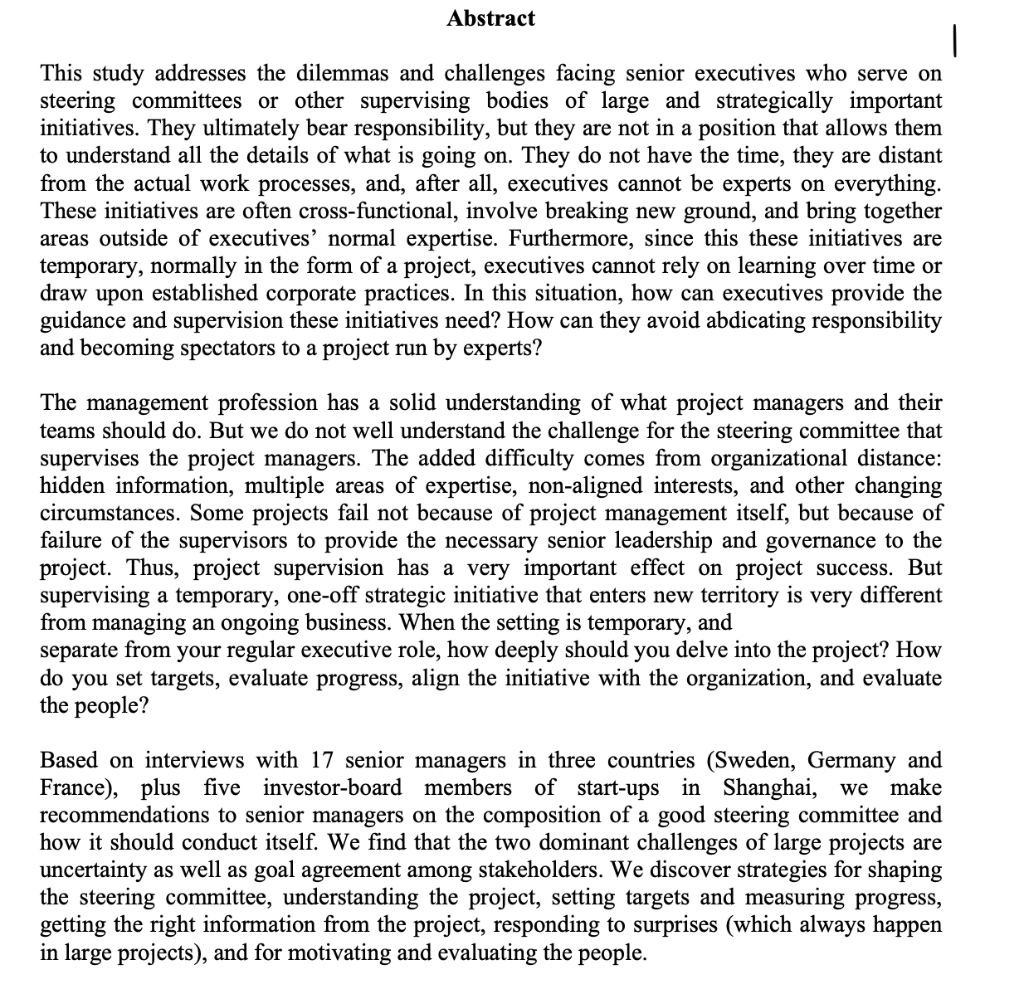
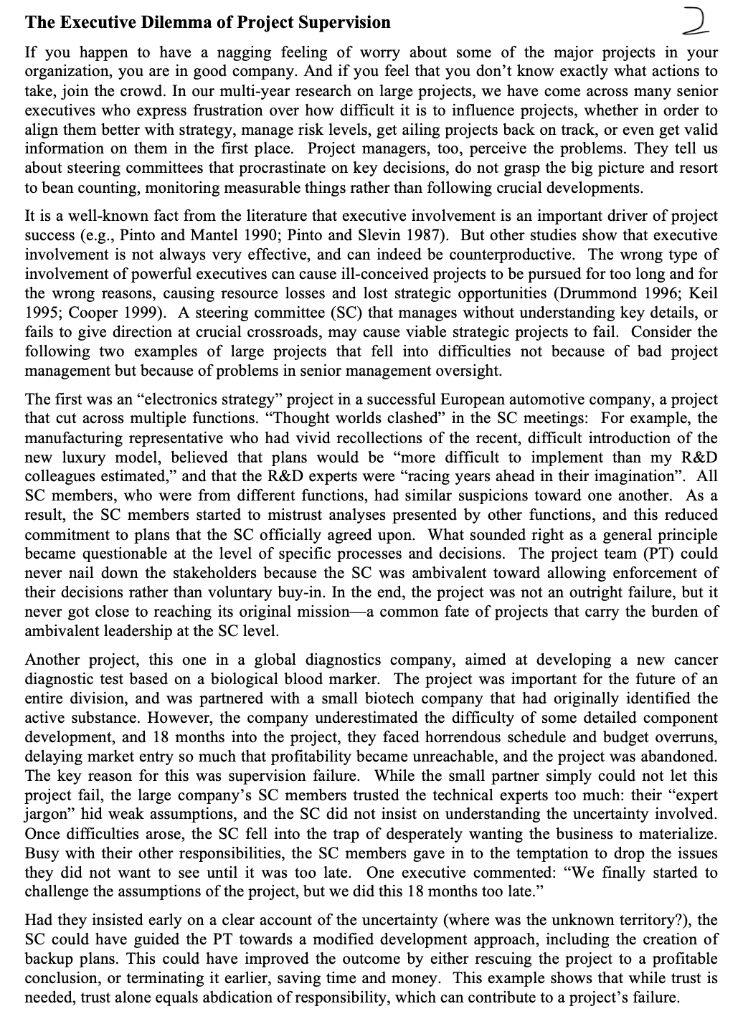
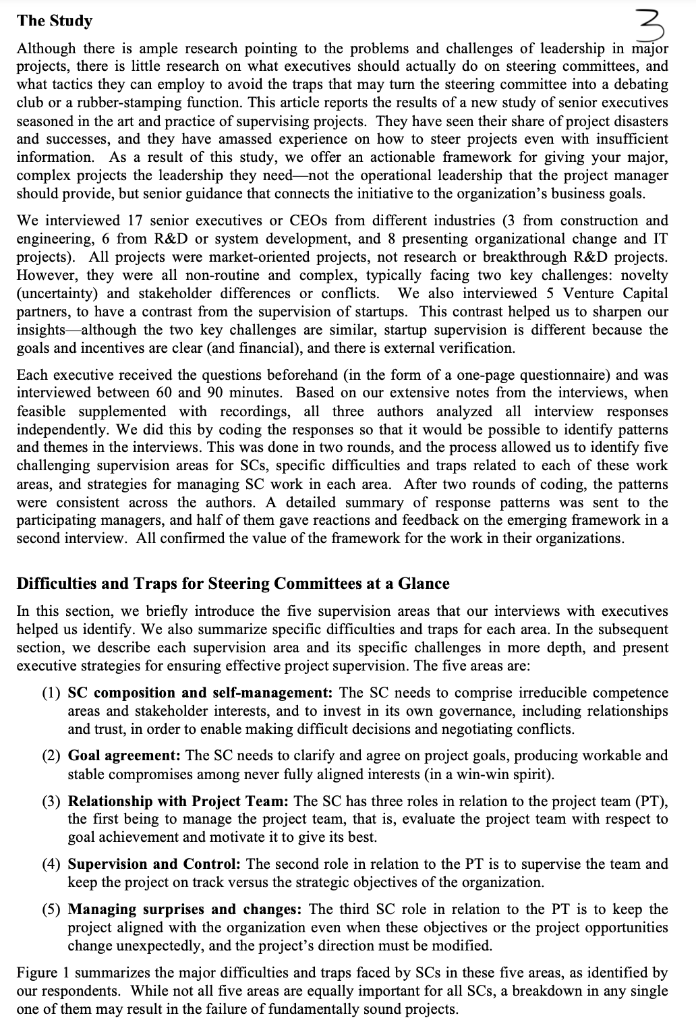
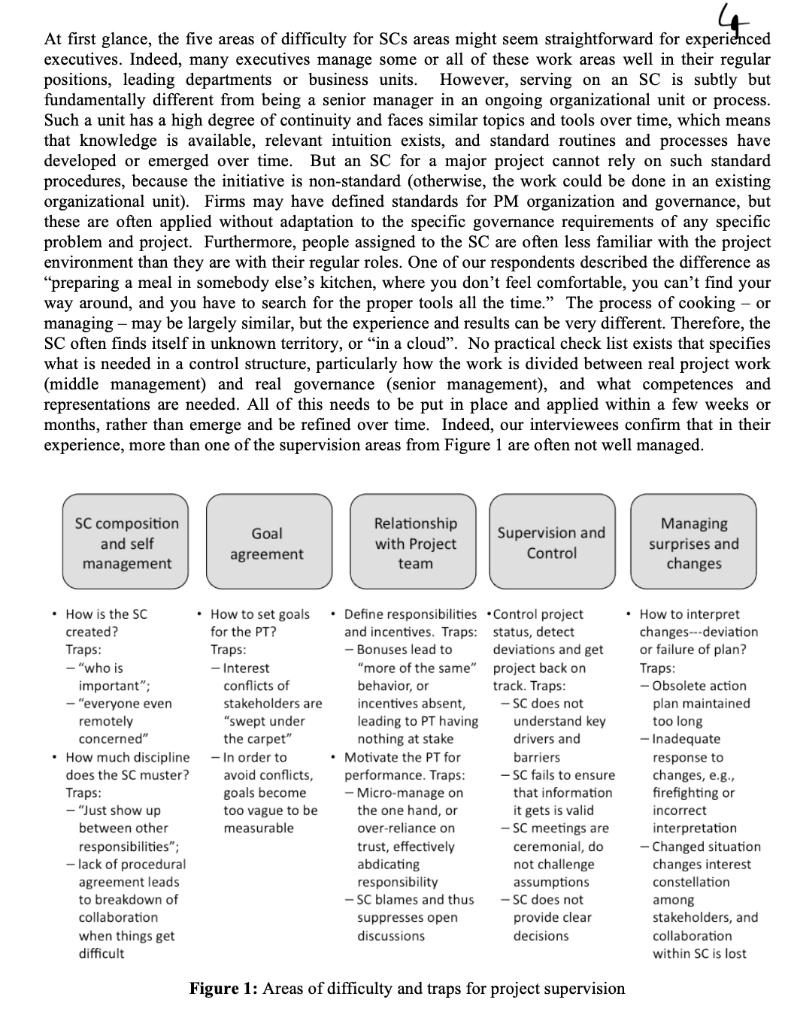
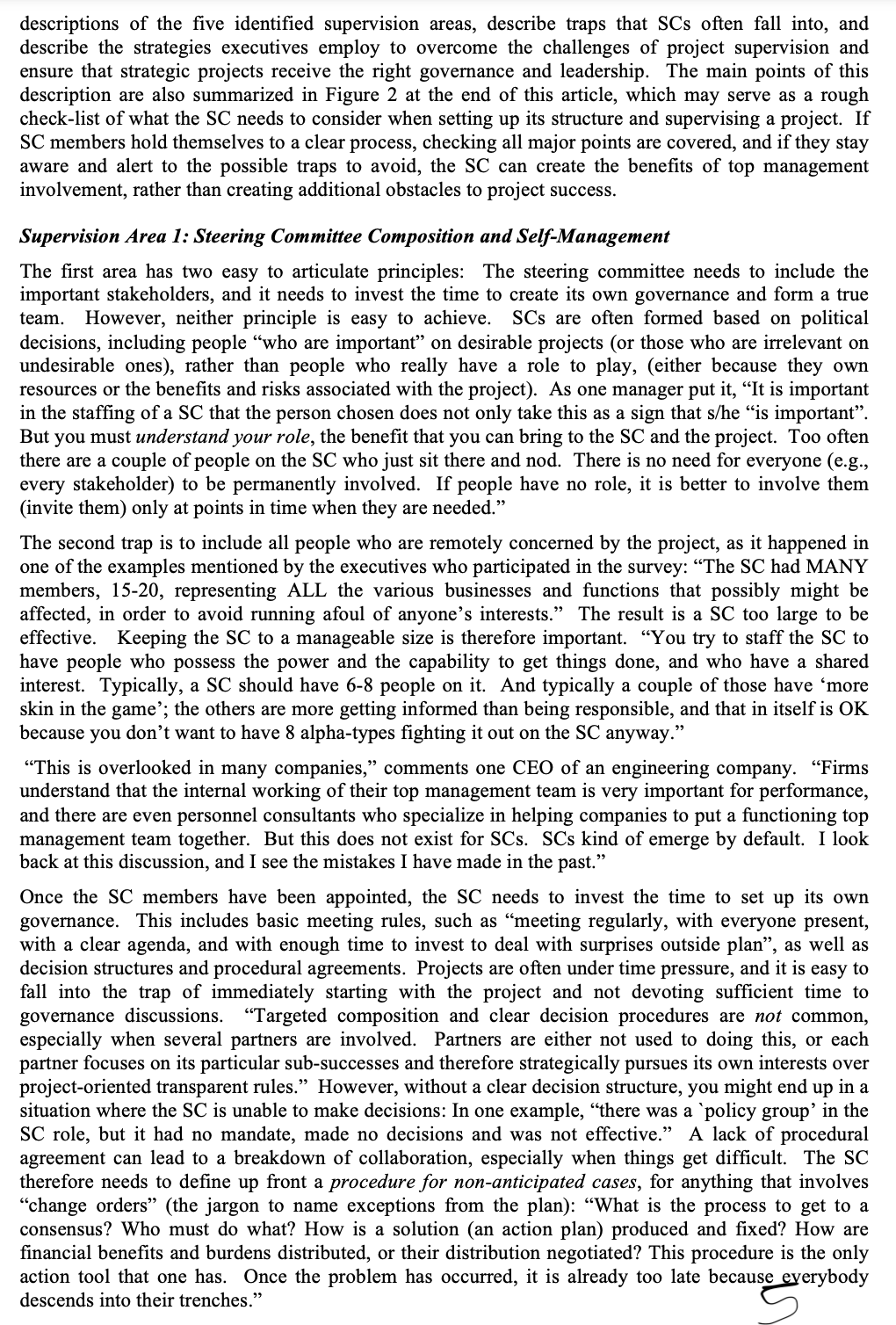
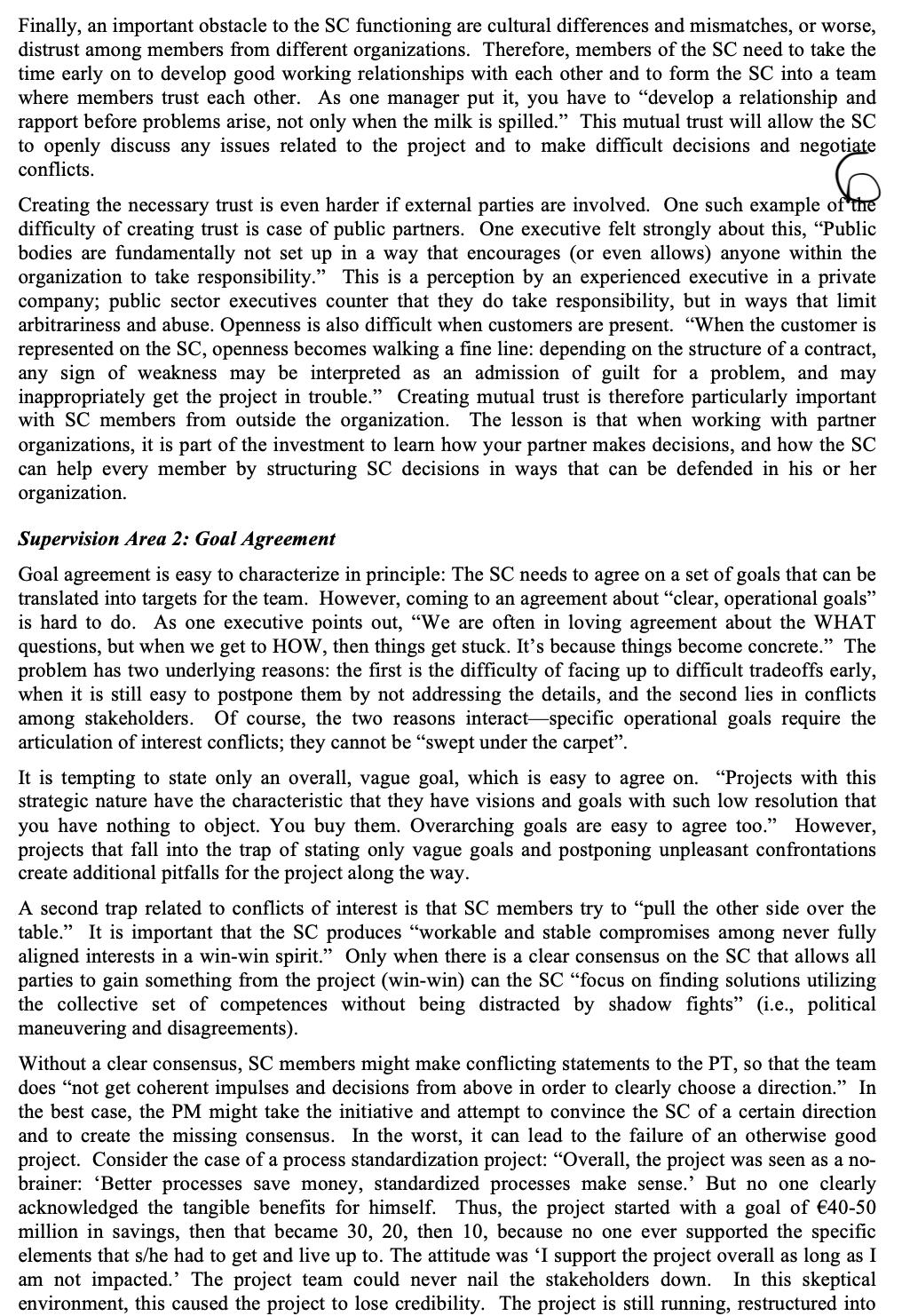
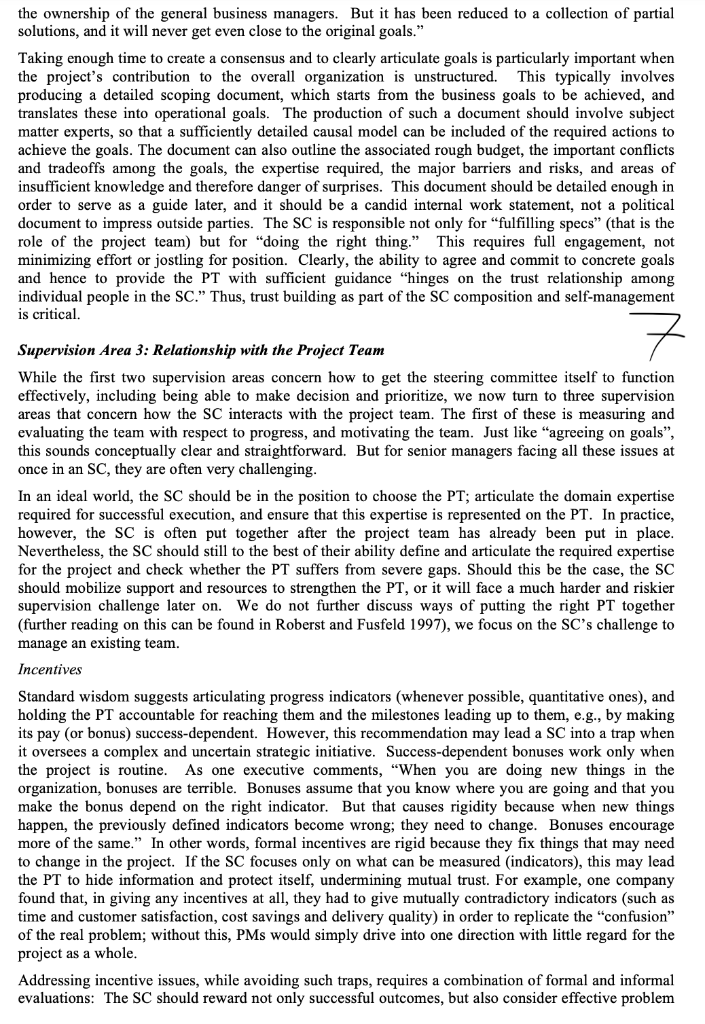
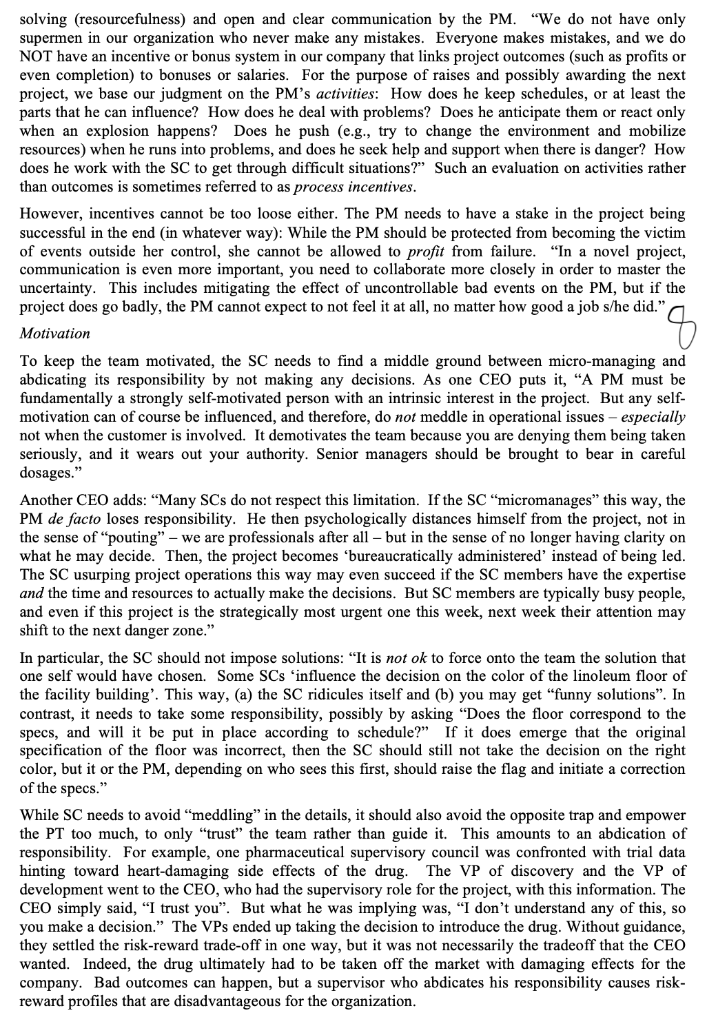

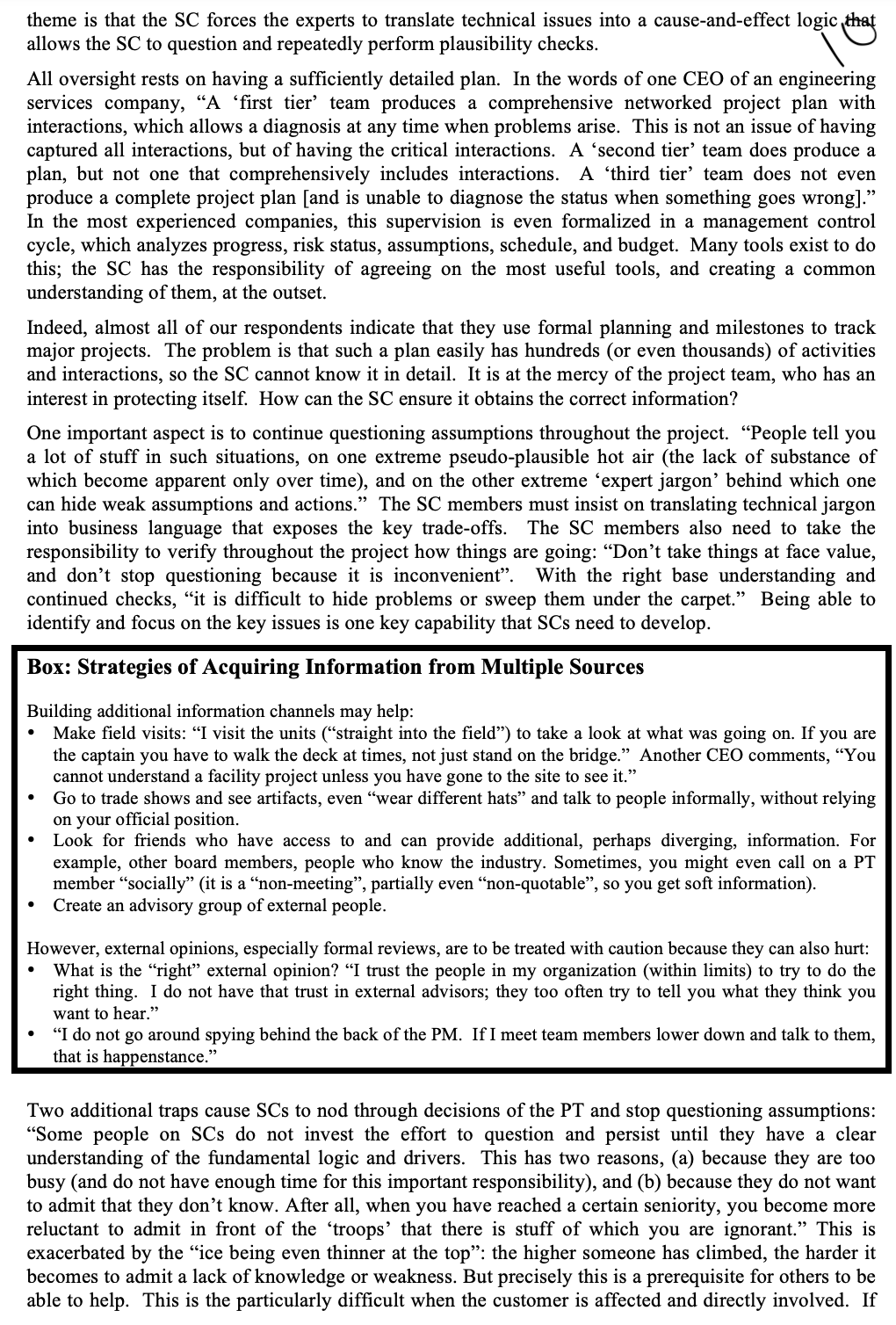
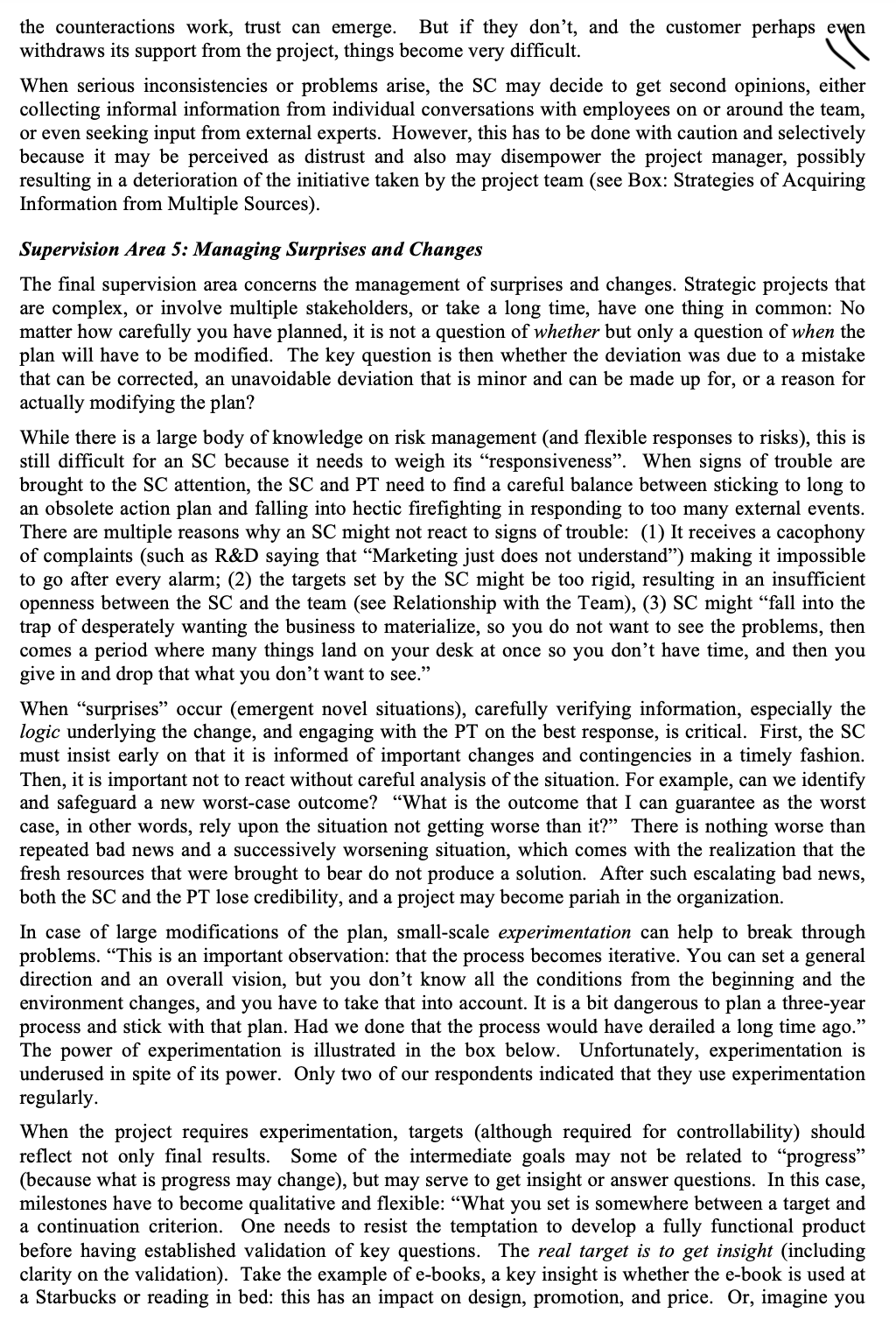
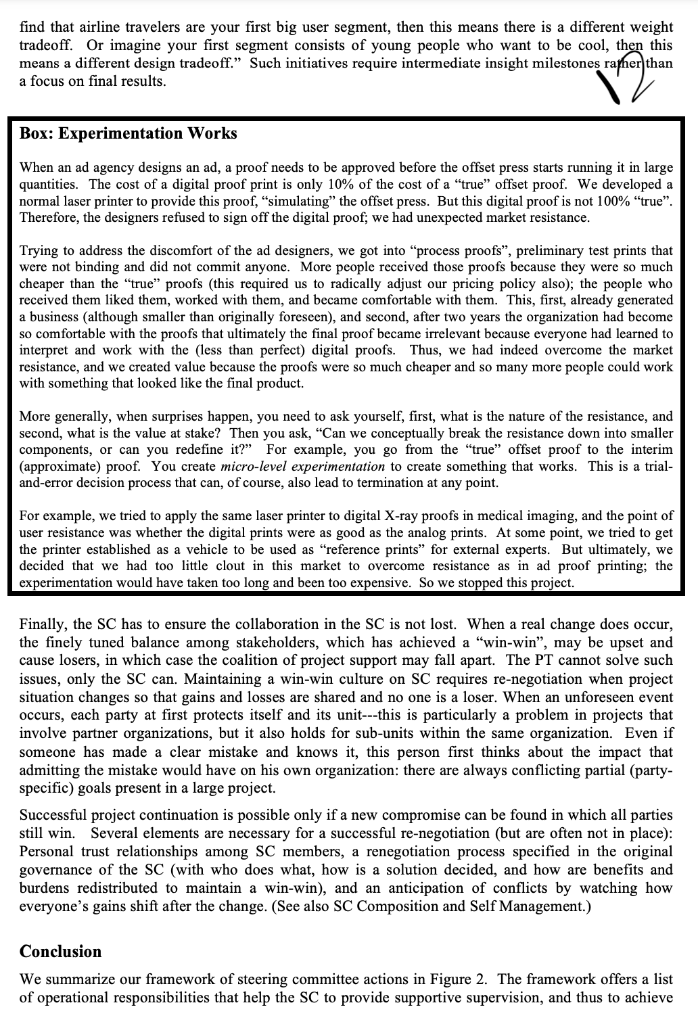

Abstract This study addresses the dilemmas and challenges facing senior executives who serve on steering committees or other supervising bodies of large and strategically important initiatives. They ultimately bear responsibility, but they are not in a position that allows them to understand all the details of what is going on. They do not have the time, they are distant from the actual work processes, and, after all, executives cannot be experts on everything. These initiatives are often cross-functional, involve breaking new ground, and bring together areas outside of executives' normal expertise. Furthermore, since this these initiatives are temporary, normally in the form of a project, executives cannot rely on learning over time or draw upon established corporate practices. In this situation, how can executives provide the guidance and supervision these initiatives need? How can they avoid abdicating responsibility and becoming spectators to a project run by experts? The management profession has a solid understanding of what project managers and their teams should do. But we do not well understand the challenge for the steering committee that supervises the project managers. The added difficulty comes from organizational distance: hidden information, multiple areas of expertise, non-aligned interests, and other changing circumstances. Some projects fail not because of project management itself, but because of failure of the supervisors to provide the necessary senior leadership and governance to the project. Thus, project supervision has a very important effect on project success. But supervising a temporary, one-off strategic initiative that enters new territory is very different from managing an ongoing business. When the setting is temporary, and separate from your regular executive role, how deeply should you delve into the project? How do you set targets, evaluate progress, align the initiative with the organization, and evaluate the people? Based on interviews with 17 senior managers in three countries (Sweden, Germany and France), plus five investor-board members of start-ups in Shanghai, we make recommendations to senior managers on the composition of a good steering committee and how it should conduct itself. We find that the two dominant challenges of large projects are uncertainty as well as goal agreement among stakeholders. We discover strategies for shaping the steering committee, understanding the project, setting targets and measuring progress, getting the right information from the project, responding to surprises (which always happen in large projects), and for motivating and evaluating the people. The Executive Dilemma of Project Supervision If you happen to have a nagging feeling of worry about some of the major projects in your organization, you are in good company. And if you feel that you don't know exactly what actions to take, join the crowd. In our multi-year research on large projects, we have come across many senior executives who express frustration over how difficult it is to influence projects, whether in order to align them better with strategy, manage risk levels, get ailing projects back on track, or even get valid information on them in the first place. Project managers, too, perceive the problems. They tell us about steering committees that procrastinate on key decisions, do not grasp the big picture and resort to bean counting, monitoring measurable things rather than following crucial developments. It is a well-known fact from the literature that executive involvement is an important driver of project success (e.g., Pinto and Mantel 1990; Pinto and Slevin 1987). But other studies show that executive involvement is not always very effective, and can indeed be counterproductive. The wrong type of involvement of powerful executives can cause ill-conceived projects to be pursued for too long and for the wrong reasons, causing resource losses and lost strategic opportunities (Drummond 1996; Keil 1995; Cooper 1999). A steering committee (SC) that manages without understanding key details, or fails to give direction at crucial crossroads, may cause viable strategic projects to fail. Consider the following two examples of large projects that fell into difficulties not because of bad project management but because of problems in senior management oversight. The first was an "electronics strategy" project in a successful European automotive company, a project that cut across multiple functions. "Thought worlds clashed" in the SC meetings: For example, the manufacturing representative who had vivid recollections of the recent, difficult introduction of the new luxury model, believed that plans would be "more difficult to implement than my R\&D colleagues estimated," and that the R\&D experts were "racing years ahead in their imagination". All SC members, who were from different functions, had similar suspicions toward one another. As a result, the SC members started to mistrust analyses presented by other functions, and this reduced commitment to plans that the SC officially agreed upon. What sounded right as a general principle became questionable at the level of specific processes and decisions. The project team (PT) could never nail down the stakeholders because the SC was ambivalent toward allowing enforcement of their decisions rather than voluntary buy-in. In the end, the project was not an outright failure, but it never got close to reaching its original mission-a common fate of projects that carry the burden of ambivalent leadership at the SC level. Another project, this one in a global diagnostics company, aimed at developing a new cancer diagnostic test based on a biological blood marker. The project was important for the future of an entire division, and was partnered with a small biotech company that had originally identified the active substance. However, the company underestimated the difficulty of some detailed component development, and 18 months into the project, they faced horrendous schedule and budget overruns, delaying market entry so much that profitability became unreachable, and the project was abandoned. The key reason for this was supervision failure. While the small partner simply could not let this project fail, the large company's SC members trusted the technical experts too much: their "expert jargon" hid weak assumptions, and the SC did not insist on understanding the uncertainty involved. Once difficulties arose, the SC fell into the trap of desperately wanting the business to materialize. Busy with their other responsibilities, the SC members gave in to the temptation to drop the issues they did not want to see until it was too late. One executive commented: "We finally started to challenge the assumptions of the project, but we did this 18 months too late." Had they insisted early on a clear account of the uncertainty (where was the unknown territory?), the SC could have guided the PT towards a modified development approach, including the creation of backup plans. This could have improved the outcome by either rescuing the project to a profitable conclusion, or terminating it earlier, saving time and money. This example shows that while trust is needed, trust alone equals abdication of responsibility, which can contribute to a project's failure. The Study Although there is ample research pointing to the problems and challenges of leadership in major projects, there is little research on what executives should actually do on steering committees, and what tactics they can employ to avoid the traps that may turn the steering committee into a debating club or a rubber-stamping function. This article reports the results of a new study of senior executives seasoned in the art and practice of supervising projects. They have seen their share of project disasters and successes, and they have amassed experience on how to steer projects even with insufficient information. As a result of this study, we offer an actionable framework for giving your major, complex projects the leadership they need-not the operational leadership that the project manager should provide, but senior guidance that connects the initiative to the organization's business goals. We interviewed 17 senior executives or CEOs from different industries (3 from construction and engineering, 6 from R\&D or system development, and 8 presenting organizational change and IT projects). All projects were market-oriented projects, not research or breakthrough R\&D projects. However, they were all non-routine and complex, typically facing two key challenges: novelty (uncertainty) and stakeholder differences or conflicts. We also interviewed 5 Venture Capital partners, to have a contrast from the supervision of startups. This contrast helped us to sharpen our insights - although the two key challenges are similar, startup supervision is different because the goals and incentives are clear (and financial), and there is external verification. Each executive received the questions beforehand (in the form of a one-page questionnaire) and was interviewed between 60 and 90 minutes. Based on our extensive notes from the interviews, when feasible supplemented with recordings, all three authors analyzed all interview responses independently. We did this by coding the responses so that it would be possible to identify patterns and themes in the interviews. This was done in two rounds, and the process allowed us to identify five challenging supervision areas for SCs, specific difficulties and traps related to each of these work areas, and strategies for managing SC work in each area. After two rounds of coding, the patterns were consistent across the authors. A detailed summary of response patterns was sent to the participating managers, and half of them gave reactions and feedback on the emerging framework in a second interview. All confirmed the value of the framework for the work in their organizations. Difficulties and Traps for Steering Committees at a Glance In this section, we briefly introduce the five supervision areas that our interviews with executives helped us identify. We also summarize specific difficulties and traps for each area. In the subsequent section, we describe each supervision area and its specific challenges in more depth, and present executive strategies for ensuring effective project supervision. The five areas are: (1) SC composition and self-management: The SC needs to comprise irreducible competence areas and stakeholder interests, and to invest in its own governance, including relationships and trust, in order to enable making difficult decisions and negotiating conflicts. (2) Goal agreement: The SC needs to clarify and agree on project goals, producing workable and stable compromises among never fully aligned interests (in a win-win spirit). (3) Relationship with Project Team: The SC has three roles in relation to the project team (PT), the first being to manage the project team, that is, evaluate the project team with respect to goal achievement and motivate it to give its best. (4) Supervision and Control: The second role in relation to the PT is to supervise the team and keep the project on track versus the strategic objectives of the organization. (5) Managing surprises and changes: The third SC role in relation to the PT is to keep the project aligned with the organization even when these objectives or the project opportunities change unexpectedly, and the project's direction must be modified. Figure 1 summarizes the major difficulties and traps faced by SCs in these five areas, as identified by our respondents. While not all five areas are equally important for all SCs, a breakdown in any single one of them may result in the failure of fundamentally sound projects. At first glance, the five areas of difficulty for SCs areas might seem straightforward for experienced executives. Indeed, many executives manage some or all of these work areas well in their regular positions, leading departments or business units. However, serving on an SC is subtly but fundamentally different from being a senior manager in an ongoing organizational unit or process. Such a unit has a high degree of continuity and faces similar topics and tools over time, which means that knowledge is available, relevant intuition exists, and standard routines and processes have developed or emerged over time. But an SC for a major project cannot rely on such standard procedures, because the initiative is non-standard (otherwise, the work could be done in an existing organizational unit). Firms may have defined standards for PM organization and governance, but these are often applied without adaptation to the specific governance requirements of any specific problem and project. Furthermore, people assigned to the SC are often less familiar with the project environment than they are with their regular roles. One of our respondents described the difference as "preparing a meal in somebody else's kitchen, where you don't feel comfortable, you can't find your way around, and you have to search for the proper tools all the time." The process of cooking - or managing - may be largely similar, but the experience and results can be very different. Therefore, the SC often finds itself in unknown territory, or "in a cloud". No practical check list exists that specifies what is needed in a control structure, particularly how the work is divided between real project work (middle management) and real governance (senior management), and what competences and representations are needed. All of this needs to be put in place and applied within a few weeks or months, rather than emerge and be refined over time. Indeed, our interviewees confirm that in their experience, more than one of the supervision areas from Figure 1 are often not well managed. Figure 1: Areas of difficulty and traps for project supervision Finally, an important obstacle to the SC functioning are cultural differences and mismatches, or worse, distrust among members from different organizations. Therefore, members of the SC need to take the time early on to develop good working relationships with each other and to form the SC into a team where members trust each other. As one manager put it, you have to "develop a relationship and rapport before problems arise, not only when the milk is spilled." This mutual trust will allow the SC to openly discuss any issues related to the project and to make difficult decisions and negotiate conflicts. Creating the necessary trust is even harder if external parties are involved. One such example of the difficulty of creating trust is case of public partners. One executive felt strongly about this, "Public bodies are fundamentally not set up in a way that encourages (or even allows) anyone within the organization to take responsibility." This is a perception by an experienced executive in a private company; public sector executives counter that they do take responsibility, but in ways that limit arbitrariness and abuse. Openness is also difficult when customers are present. "When the customer is represented on the SC, openness becomes walking a fine line: depending on the structure of a contract, any sign of weakness may be interpreted as an admission of guilt for a problem, and may inappropriately get the project in trouble." Creating mutual trust is therefore particularly important with SC members from outside the organization. The lesson is that when working with partner organizations, it is part of the investment to learn how your partner makes decisions, and how the SC can help every member by structuring SC decisions in ways that can be defended in his or her organization. Supervision Area 2: Goal Agreement Goal agreement is easy to characterize in principle: The SC needs to agree on a set of goals that can be translated into targets for the team. However, coming to an agreement about "clear, operational goals" is hard to do. As one executive points out, "We are often in loving agreement about the WHAT questions, but when we get to HOW, then things get stuck. It's because things become concrete." The problem has two underlying reasons: the first is the difficulty of facing up to difficult tradeoffs early, when it is still easy to postpone them by not addressing the details, and the second lies in conflicts among stakeholders. Of course, the two reasons interact-specific operational goals require the articulation of interest conflicts; they cannot be "swept under the carpet". It is tempting to state only an overall, vague goal, which is easy to agree on. "Projects with this strategic nature have the characteristic that they have visions and goals with such low resolution that you have nothing to object. You buy them. Overarching goals are easy to agree too." However, projects that fall into the trap of stating only vague goals and postponing unpleasant confrontations create additional pitfalls for the project along the way. A second trap related to conflicts of interest is that SC members try to "pull the other side over the table." It is important that the SC produces "workable and stable compromises among never fully aligned interests in a win-win spirit." Only when there is a clear consensus on the SC that allows all parties to gain something from the project (win-win) can the SC "focus on finding solutions utilizing the collective set of competences without being distracted by shadow fights" (i.e., political maneuvering and disagreements). Without a clear consensus, SC members might make conflicting statements to the PT, so that the team does "not get coherent impulses and decisions from above in order to clearly choose a direction." In the best case, the PM might take the initiative and attempt to convince the SC of a certain direction and to create the missing consensus. In the worst, it can lead to the failure of an otherwise good project. Consider the case of a process standardization project: "Overall, the project was seen as a nobrainer: 'Better processes save money, standardized processes make sense.' But no one clearly acknowledged the tangible benefits for himself. Thus, the project started with a goal of 4050 million in savings, then that became 30,20 , then 10 , because no one ever supported the specific elements that s/ he had to get and live up to. The attitude was 'I support the project overall as long as I am not impacted.' The project team could never nail the stakeholders down. In this skeptical environment, this caused the project to lose credibility. The project is still running, restructured into solutions, and it will never get even close to the original goals." Taking enough time to create a consensus and to clearly articulate goals is particularly important when the project's contribution to the overall organization is unstructured. This typically involves producing a detailed scoping document, which starts from the business goals to be achieved, and translates these into operational goals. The production of such a document should involve subject matter experts, so that a sufficiently detailed causal model can be included of the required actions to achieve the goals. The document can also outline the associated rough budget, the important conflicts and tradeoffs among the goals, the expertise required, the major barriers and risks, and areas of insufficient knowledge and therefore danger of surprises. This document should be detailed enough in order to serve as a guide later, and it should be a candid internal work statement, not a political document to impress outside parties. The SC is responsible not only for "fulfilling specs" (that is the role of the project team) but for "doing the right thing." This requires full engagement, not minimizing effort or jostling for position. Clearly, the ability to agree and commit to concrete goals and hence to provide the PT with sufficient guidance "hinges on the trust relationship among individual people in the SC." Thus, trust building as part of the SC composition and self-management is critical. Supervision Area 3: Relationship with the Project Team While the first two supervision areas concern how to get the steering committee itself to function effectively, including being able to make decision and prioritize, we now turn to three supervision areas that concern how the SC interacts with the project team. The first of these is measuring and evaluating the team with respect to progress, and motivating the team. Just like "agreeing on goals", this sounds conceptually clear and straightforward. But for senior managers facing all these issues at once in an SC, they are often very challenging. In an ideal world, the SC should be in the position to choose the PT; articulate the domain expertise required for successful execution, and ensure that this expertise is represented on the PT. In practice, however, the SC is often put together after the project team has already been put in place. Nevertheless, the SC should still to the best of their ability define and articulate the required expertise for the project and check whether the PT suffers from severe gaps. Should this be the case, the SC should mobilize support and resources to strengthen the PT, or it will face a much harder and riskier supervision challenge later on. We do not further discuss ways of putting the right PT together (further reading on this can be found in Roberst and Fusfeld 1997), we focus on the SC's challenge to manage an existing team. Incentives Standard wisdom suggests articulating progress indicators (whenever possible, quantitative ones), and holding the PT accountable for reaching them and the milestones leading up to them, e.g., by making its pay (or bonus) success-dependent. However, this recommendation may lead a SC into a trap when it oversees a complex and uncertain strategic initiative. Success-dependent bonuses work only when the project is routine. As one executive comments, "When you are doing new things in the organization, bonuses are terrible. Bonuses assume that you know where you are going and that you make the bonus depend on the right indicator. But that causes rigidity because when new things happen, the previously defined indicators become wrong; they need to change. Bonuses encourage more of the same." In other words, formal incentives are rigid because they fix things that may need to change in the project. If the SC focuses only on what can be measured (indicators), this may lead the PT to hide information and protect itself, undermining mutual trust. For example, one company found that, in giving any incentives at all, they had to give mutually contradictory indicators (such as time and customer satisfaction, cost savings and delivery quality) in order to replicate the "confusion" of the real problem; without this, PMs would simply drive into one direction with little regard for the project as a whole. Addressing incentive issues, while avoiding such traps, requires a combination of formal and informal evaluations: The SC should reward not only successful outcomes, but also consider effective problem solving (resourcefulness) and open and clear communication by the PM. "We do not have only supermen in our organization who never make any mistakes. Everyone makes mistakes, and we do NOT have an incentive or bonus system in our company that links project outcomes (such as profits or even completion) to bonuses or salaries. For the purpose of raises and possibly awarding the next project, we base our judgment on the PM's activities: How does he keep schedules, or at least the parts that he can influence? How does he deal with problems? Does he anticipate them or react only when an explosion happens? Does he push (e.g., try to change the environment and mobilize resources) when he runs into problems, and does he seek help and support when there is danger? How does he work with the SC to get through difficult situations?" Such an evaluation on activities rather than outcomes is sometimes referred to as process incentives. However, incentives cannot be too loose either. The PM needs to have a stake in the project being successful in the end (in whatever way): While the PM should be protected from becoming the victim of events outside her control, she cannot be allowed to profit from failure. "In a novel project, communication is even more important, you need to collaborate more closely in order to master the uncertainty. This includes mitigating the effect of uncontrollable bad events on the PM, but if the project does go badly, the PM cannot expect to not feel it at all, no matter how good a job s/he did." Motivation To keep the team motivated, the SC needs to find a middle ground between micro-managing and abdicating its responsibility by not making any decisions. As one CEO puts it, "A PM must be fundamentally a strongly self-motivated person with an intrinsic interest in the project. But any selfmotivation can of course be influenced, and therefore, do not meddle in operational issues - especially not when the customer is involved. It demotivates the team because you are denying them being taken seriously, and it wears out your authority. Senior managers should be brought to bear in careful dosages." Another CEO adds: "Many SCs do not respect this limitation. If the SC "micromanages" this way, the PM de facto loses responsibility. He then psychologically distances himself from the project, not in the sense of "pouting" - we are professionals after all - but in the sense of no longer having clarity on what he may decide. Then, the project becomes 'bureaucratically administered' instead of being led. The SC usurping project operations this way may even succeed if the SC members have the expertise and the time and resources to actually make the decisions. But SC members are typically busy people, and even if this project is the strategically most urgent one this week, next week their attention may shift to the next danger zone." In particular, the SC should not impose solutions: "It is not ok to force onto the team the solution that one self would have chosen. Some SCs 'influence the decision on the color of the linoleum floor of the facility building'. This way, (a) the SC ridicules itself and (b) you may get "funny solutions". In contrast, it needs to take some responsibility, possibly by asking "Does the floor correspond to the specs, and will it be put in place according to schedule?" If it does emerge that the original specification of the floor was incorrect, then the SC should still not take the decision on the right color, but it or the PM, depending on who sees this first, should raise the flag and initiate a correction of the specs." While SC needs to avoid "meddling" in the details, it should also avoid the opposite trap and empower the PT too much, to only "trust" the team rather than guide it. This amounts to an abdication of responsibility. For example, one pharmaceutical supervisory council was confronted with trial data hinting toward heart-damaging side effects of the drug. The VP of discovery and the VP of development went to the CEO, who had the supervisory role for the project, with this information. The CEO simply said, "I trust you". But what he was implying was, "I don't understand any of this, so you make a decision." The VPs ended up taking the decision to introduce the drug. Without guidance, they settled the risk-reward trade-off in one way, but it was not necessarily the tradeoff that the CEO wanted. Indeed, the drug ultimately had to be taken off the market with damaging effects for the company. Bad outcomes can happen, but a supervisor who abdicates his responsibility causes riskreward profiles that are disadvantageous for the organization. How the supervising body can learn enough to know when to ask questions, to understand the tradeoffs and to be able to provide the necessary guidance is discussed in the next section, Supervision and Control. Here, we discuss one key element of the relationship between the SC and the project team that enables effective supervision and control: an open discussion and exchange, a no-blame culture where the "messenger is not in danger of being shot". Openness and a "no-blame" culture are desirable but require discipline, not always adhered to by senior managers. "Mistakes are caused by many reasons. It is a natural reaction by the SC to become irritated when a mistake was covered up. But the trick is to not get into a negative spiral. Make it unambiguously clear that the rules here require openness in order to be able to collaborate, but at least the first few times the SC should also show some understanding and sympathy. It is a trap to fall too quickly into a suspicion of feeling cheated." At another pharmaceutical company, the VP heading development was on his way to the Award ceremony, where outstanding project teams were honored for their work. On the way, he learned from an urgent phone call by the PM that an unexpected toxicity problem had arisen in the very drug that was scheduled to win the award. Upon his arrival at the venue, he explained this to the CEO: should they cancel the award for this team? They decided to go ahead and award the team, but afterward, they took the team to the side and alerted it that top management was aware of the issue. The CEO criticized and partly blamed the VP in front of the team for the fact that this problem had been discovered so late. But the VP resisted blaming the team; he simply swallowed the criticism. This showed them that they could trust him, and they doubled their efforts. And three weeks later, they achieved a breakthrough and were able to reduce the toxicity by 70%, so the drug could safely go ahead. That is the power of a no-blame culture. Finally, a way to swat two flies with the same stroke is to perform coaching: "Sometimes, the team members themselves learn in the project, for example, when they are promising, motivated and talented, but still relatively inexperienced young people. They may make mistakes simply out of a lack of experience. Then coach them and give them the feeling that they are LEARNING. This increases project control and at the same time will be highly motivating." But coaching requires what is often not sufficiently available: time by the SC members. Prioritizing time spent is a key responsibility of the SC that needs to be made explicit rather than just "happen" in a way that is driven by events. Supervision Area 4: Focused Supervision and Control Because of the complexity and specialized expertise involved in complex strategic projects, a tight oversight (ensuring a vetting of all important decisions) is simply not feasible for the SC. Substantial delegation is unavoidable. Theories of delegation exist (e.g., Aghion and Tirole 1997, Wu et al. 2008)---they point out that delegating decisions to employees motivates them and uses specialized knowledge about the problem that the employee has. But these theories assume that the range of choices that the employee can make is known, so the resulting potential of "misalignment" is known. But this is not true for strategic projects: misalignment can become catastrophic, and moreover, it may be so subtle that it is hard to recognize at first. Thus, the abdication that we have described in the section above is a real risk that can arise without the SC realizing it. The SC must ride a delicate balance between control and delegation. While trust is critical for delegation, each SC member must invest enough time and effort to understand the logic of how the project will achieve its goals. For example, it is the task of the PM to develop "controllable milestones". The SC does not develop milestones, but it is the responsibility of the SC to question the milestones and to ensure that they are linked to clear, measurable outcomes based on which progress can be observed. "I must understand what the [fulfillment of the] milestone gives me what I did not have before: a clear analysis, a partial functionality, a customer compatibility, etc." As one executive puts it, "The SC is not the staircase (that's the PT), the SC is the handrail that guides the direction." Our participating executives found different words for this, some admitting that "you can know only 60% of the important facts", and some explaining key concepts to master, such as cause-and-effect of key actions, the business case, or the key risks and barriers that might stand in the way. The common theme is that the SC forces the experts to translate technical issues into a cause-and-effect logic, that allows the SC to question and repeatedly perform plausibility checks. All oversight rests on having a sufficiently detailed plan. In the words of one CEO of an engineering services company, "A 'first tier' team produces a comprehensive networked project plan with interactions, which allows a diagnosis at any time when problems arise. This is not an issue of having captured all interactions, but of having the critical interactions. A 'second tier' team does produce a plan, but not one that comprehensively includes interactions. A 'third tier' team does not even produce a complete project plan [and is unable to diagnose the status when something goes wrong]." In the most experienced companies, this supervision is even formalized in a management control cycle, which analyzes progress, risk status, assumptions, schedule, and budget. Many tools exist to do this; the SC has the responsibility of agreeing on the most useful tools, and creating a common understanding of them, at the outset. Indeed, almost all of our respondents indicate that they use formal planning and milestones to track major projects. The problem is that such a plan easily has hundreds (or even thousands) of activities and interactions, so the SC cannot know it in detail. It is at the mercy of the project team, who has an interest in protecting itself. How can the SC ensure it obtains the correct information? One important aspect is to continue questioning assumptions throughout the project. "People tell you a lot of stuff in such situations, on one extreme pseudo-plausible hot air (the lack of substance of which become apparent only over time), and on the other extreme 'expert jargon' behind which one can hide weak assumptions and actions." The SC members must insist on translating technical jargon into business language that exposes the key trade-offs. The SC members also need to take the responsibility to verify throughout the project how things are going: "Don't take things at face value, and don't stop questioning because it is inconvenient". With the right base understanding and continued checks, "it is difficult to hide problems or sweep them under the carpet." Being able to identify and focus on the key issues is one key capability that SCs need to develop. Box: Strategies of Acquiring Information from Multiple Sources Building additional information channels may help: - Make field visits: "I visit the units ("straight into the field") to take a look at what was going on. If you are the captain you have to walk the deck at times, not just stand on the bridge." Another CEO comments, "You cannot understand a facility project unless you have gone to the site to see it." - Go to trade shows and see artifacts, even "wear different hats" and talk to people informally, without relying on your official position. - Look for friends who have access to and can provide additional, perhaps diverging, information. For example, other board members, people who know the industry. Sometimes, you might even call on a PT member "socially" (it is a "non-meeting", partially even "non-quotable", so you get soft information). - Create an advisory group of external people. However, external opinions, especially formal reviews, are to be treated with caution because they can also hurt: - What is the "right" external opinion? "I trust the people in my organization (within limits) to try to do the right thing. I do not have that trust in external advisors; they too often try to tell you what they think you want to hear." - "I do not go around spying behind the back of the PM. If I meet team members lower down and talk to them, that is happenstance." Two additional traps cause SCs to nod through decisions of the PT and stop questioning assumptions: "Some people on SCs do not invest the effort to question and persist until they have a clear understanding of the fundamental logic and drivers. This has two reasons, (a) because they are too busy (and do not have enough time for this important responsibility), and (b) because they do not want to admit that they don't know. After all, when you have reached a certain seniority, you become more reluctant to admit in front of the 'troops' that there is stuff of which you are ignorant." This is exacerbated by the "ice being even thinner at the top": the higher someone has climbed, the harder it becomes to admit a lack of knowledge or weakness. But precisely this is a prerequisite for others to be able to help. This is the particularly difficult when the customer is affected and directly involved. If find that airline travelers are your first big user segment, then this means there is a different weight tradeoff. Or imagine your first segment consists of young people who want to be cool, then this means a different design tradeoff." Such initiatives require intermediate insight milestones raper than a focus on final results. Box: Experimentation Works When an ad agency designs an ad, a proof needs to be approved before the offset press starts running it in large quantities. The cost of a digital proof print is only 10% of the cost of a "true" offset proof. We developed a normal laser printer to provide this proof, "simulating" the offset press. But this digital proof is not 100% "true". Therefore, the designers refused to sign off the digital proof; we had unexpected market resistance. Trying to address the discomfort of the ad designers, we got into "process proofs", preliminary test prints that were not binding and did not commit anyone. More people received those proofs because they were so much cheaper than the "true" proofs (this required us to radically adjust our pricing policy also); the people who received them liked them, worked with them, and became comfortable with them. This, first, already generated a business (although smaller than originally foreseen), and second, after two years the organization had become so comfortable with the proofs that ultimately the final proof became irrelevant because everyone had learned to interpret and work with the (less than perfect) digital proofs. Thus, we had indeed overcome the market resistance, and we created value because the proofs were so much cheaper and so many more people could work with something that looked like the final product. More generally, when surprises happen, you need to ask yourself, first, what is the nature of the resistance, and second, what is the value at stake? Then you ask, "Can we conceptually break the resistance down into smaller components, or can you redefine it?" For example, you go from the "true" offset proof to the interim (approximate) proof. You create micro-level experimentation to create something that works. This is a trialand-error decision process that can, of course, also lead to termination at any point. For example, we tried to apply the same laser printer to digital X-ray proofs in medical imaging, and the point of user resistance was whether the digital prints were as good as the analog prints. At some point, we tried to get the printer established as a vehicle to be used as "reference prints" for external experts. But ultimately, we decided that we had too little clout in this market to overcome resistance as in ad proof printing; the experimentation would have taken too long and been too expensive. So we stopped this project. Finally, the SC has to ensure the collaboration in the SC is not lost. When a real change does occur, the finely tuned balance among stakeholders, which has achieved a "win-win", may be upset and cause losers, in which case the coalition of project support may fall apart. The PT cannot solve such issues, only the SC can. Maintaining a win-win culture on SC requires re-negotiation when project situation changes so that gains and losses are shared and no one is a loser. When an unforeseen event occurs, each party at first protects itself and its unit---this is particularly a problem in projects that involve partner organizations, but it also holds for sub-units within the same organization. Even if someone has made a clear mistake and knows it, this person first thinks about the impact that admitting the mistake would have on his own organization: there are always conflicting partial (partyspecific) goals present in a large project. Successful project continuation is possible only if a new compromise can be found in which all parties still win. Several elements are necessary for a successful re-negotiation (but are often not in place): Personal trust relationships among SC members, a renegotiation process specified in the original governance of the SC (with who does what, how is a solution decided, and how are benefits and burdens redistributed to maintain a win-win), and an anticipation of conflicts by watching how everyone's gains shift after the change. (See also SC Composition and Self Management.) Conclusion We summarize our framework of steering committee actions in Figure 2. The framework offers a list of operational responsibilities that help the SC to provide supportive supervision, and thus to achieve the benefits of top management involvement, which are often preached, rather than causing the dysfunctionalities that are unfortunately also often observed. Maintain motivation of PT by respect, listening, and showing presence Figure 2: Summary of supervision framework as a "checklist" Supervision, which we here take to mean providing strategic leadership and guidance for large projects, is a complicated and messy affair, which can stretch the expertise of any individual, no matter how competent and accomplished. Our framework gives a holistic overview of the important supervision activities to keep in mind, it "structures the unstructured" in the words of several managers with whom we have discussed our findings. A holistic overview allows senior executives to prioritize their attention depending on the phase of the project and its current status. In particular, SCs often just "emerge"-they are put together for convenience or power reasons, but not in order to give the best guidance, and they jump into "what senior managers are expected to know how to do", without taking the time to set up the SC's governance and goals. Other organizations have rigid processes from which it is hard to deviate in case of surprises. Most organizations have some blind spots, which this holistic framework can help the SC to realize and mitigate. The framework cuts across the fields of leadership and project management, and thus helps the SC to strive for a hard-to-achieve balance. If our framework helps senior managers to attack the lacuna of the difficult balance between helpful top management involvement and destructive top management meddling, it will help creating value
Step by Step Solution
There are 3 Steps involved in it
Step: 1

Get Instant Access to Expert-Tailored Solutions
See step-by-step solutions with expert insights and AI powered tools for academic success
Step: 2

Step: 3

Ace Your Homework with AI
Get the answers you need in no time with our AI-driven, step-by-step assistance
Get Started


